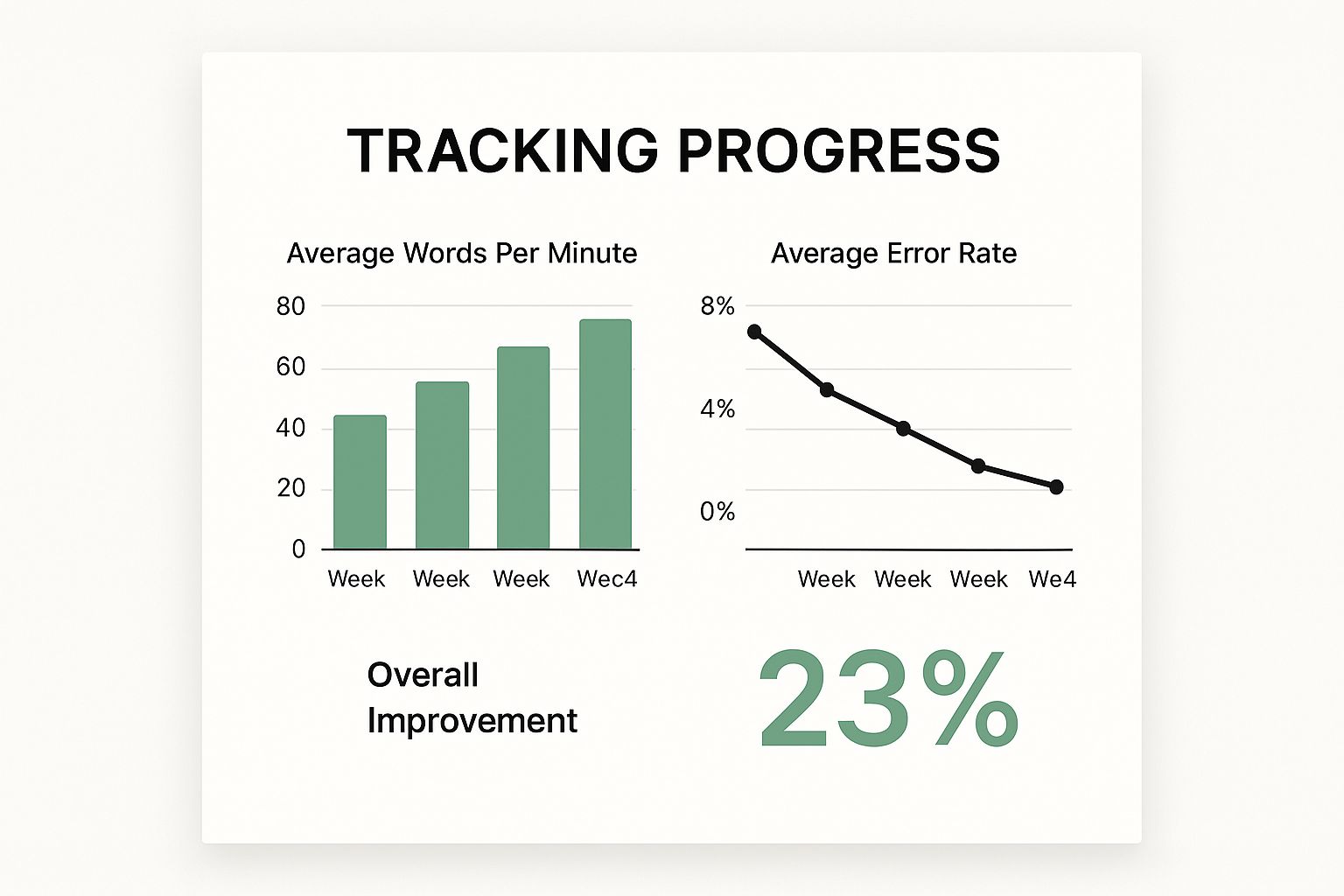
How to Write Faster and Better: Real Strategies That Work
June 21, 2025
The Truth About Writing Speed vs. Quality

Let’s get a huge myth out of the way: writing faster does not mean your work gets worse. Many of us operate under the assumption that speed is the enemy of quality. We picture fast writing as sloppy and thoughtless, while great writing must come from a slow, agonizing process. In my experience, that’s just not true. For many professional writers, speed and quality aren’t opponents—they're partners. The real enemy slowing you down is often perfectionism.
This constant need to get every word "just right" on the first pass is a major roadblock. It turns the creative flow of drafting into a frustrating, stop-and-go exercise in self-criticism. Instead of letting your ideas spill onto the page, you're constantly second-guessing, deleting sentences, and agonizing over word choice. This habit doesn’t just kill your speed; it strangles your creativity. When you’re stuck in that loop, you're not just writing slowly—you're stopping your best ideas from ever seeing the light of day.
The Myth of the Perfect First Draft
Successful writers understand a core principle that many others miss: the first draft is not supposed to be perfect. Its only job is to exist. I like to think of it as sculpting with clay. Your first pass is just about getting a lump of clay—your raw ideas, thoughts, and arguments—onto the table. It might be messy and shapeless, but it gives you something to work with. The real magic happens later, during editing, where you shape that raw material into something polished.
Demanding perfection from the start is like trying to carve a detailed sculpture with your first swing of the hammer. It sets an impossible standard that leads to frustration and burnout. This is one of the most common traps for writers wondering how to write faster and better. They mistakenly blend the two distinct acts of drafting and editing into one painful step.
Reconnecting Speed and Skill
Interestingly, the connection between speed and skill isn't just a creative idea; it has roots in how our brains work. For instance, educational psychology studies on handwriting show a fascinating link. Research found that as young students' spelling accuracy got better, their handwriting speed often increased right alongside it. This suggests that as a core skill becomes more automatic, fluency and speed naturally follow. You can read more about the findings on writing skill development to see the data for yourself.
Applying this to your writing, the more you practice getting ideas down without judgment, the more fluent you become. Speed becomes a byproduct of confidence and process, not a sacrifice of quality. By separating the drafting and editing stages, you allow yourself to build momentum and get your thoughts out efficiently. Then, you can apply your critical eye during a dedicated revision phase, where it belongs. This two-part approach is the key to breaking free from the slow-writing trap and producing better work, faster.
Setting Yourself Up for Writing Success
The biggest difference between writers who churn out quality content and those who struggle for every word often comes down to what happens before they start typing. Simply opening a blank document and hoping for inspiration is a recipe for frustration. Instead, successful writers build a launchpad for their work, ensuring that when it’s time to write, they can achieve liftoff smoothly. This preparation isn’t about rigid rules; it's about creating an environment and a mindset that supports both speed and quality.
Thinking about how to write faster and better means thinking about your entire process, starting with your physical and mental space. Your environment sends powerful cues to your brain. If you’re trying to write on a cluttered desk where you also pay bills and scroll through social media, your brain gets mixed signals. It doesn't know it's "focus time." Creating a dedicated writing spot—even if it's just a specific corner of a room—helps build a powerful psychological trigger. When you sit there, your brain knows it's time to write.
Crafting a Foundation for Flow
Before a single paragraph is written, the groundwork must be laid. This starts with two key areas: outlining and research. Many people resist outlining because they feel it stifles creativity. However, a good outline is a roadmap, not a cage. It doesn't dictate your every turn, but it prevents you from getting lost.
Instead of a rigid, multi-level hierarchy, try a "question-based" outline. For each section of your article, write down the main question you want to answer for the reader. This approach keeps your writing conversational and focused on providing value, which naturally speeds up the process because you always know your next destination.
Similarly, batching your research is a game-changer. Don't research as you write. This common habit is a major productivity killer, as you're constantly switching between two very different mental modes: creative output and analytical input. Set aside a specific block of time before you start writing to gather all your stats, links, and background information. This way, when you enter your writing phase, you can stay in a state of flow without getting sidetracked by a "quick search" that turns into a 45-minute rabbit hole.
Your Pre-Flight Checklist for Writing
Creating a small, repeatable ritual before each writing session can drastically reduce the time it takes to get into a productive state. It could be something as simple as making a cup of tea, listening to a specific song, or doing a five-minute freewriting exercise to clear your head. This ritual signals to your brain that a deep work session is about to begin.
To help you build a productive writing space, I've put together a simple checklist. It breaks down the essential elements for creating an environment that supports both speed and quality.
| Element | Purpose | Implementation Time | Impact Level |
|---|---|---|---|
| Physical Workspace | Minimize visual clutter and create a dedicated writing zone. | 15-30 minutes (one time) | High |
| Digital Workspace | Close all unrelated tabs and turn off notifications. | 1-2 minutes (each session) | High |
| Pre-Writing Ritual | Signal to your brain that it's time to focus. | 5-10 minutes (each session) | Medium |
| Clear Outline | Provide a roadmap to prevent writer's block and rambling. | 10-20 minutes (per article) | High |
As the table shows, a few minutes of setup can have a high impact on your output. By intentionally setting the stage, you eliminate friction points that drain your mental energy. You're no longer fighting distractions or uncertainty. Instead, you're building a system where fast, high-quality writing is the natural outcome.
Getting Your First Draft Down Fast
With your writing space set and a clear plan in hand, it's time to tackle the blank page. This is where you really learn how to write faster and better. The trick isn't about typing at lightning speed; it's about changing your mindset from "writer" to "drafter." These are completely different jobs. The writer polishes and critiques, but the drafter’s only mission is to build momentum.
Your goal in this phase is just to get words down—any words—that follow your outline. You have to give yourself permission for this first attempt to be messy, awkward, and maybe even a little cringey. Think of your first draft as a rough sketch, not a finished painting. An architect doesn't start by laying perfect bricks; they begin with a blueprint and a rough foundation. Trying to write a flawless sentence on the first try is like polishing one brick before the foundation is even poured. Embracing imperfection is the most effective strategy for speed. This simple shift separates productive writers from those who are constantly stuck.
Silencing Your Inner Editor
The biggest thing slowing down your first draft is your own brain. That little voice that whispers, "That sounds clunky" or "There's a better word for that," needs to be shown the door. This is tough because it's a habit we've built over years. The best way to beat it is to just keep moving forward, no matter what.
If you can't think of the right word, don't stop. Type "TK"—a classic journalism term for "to come"—or use a placeholder in all caps, like "INSERT COOL STAT HERE," and keep going. Hit a section that needs more research? Just make a note like "[find a quote about user engagement]" and write the next part you do know. The objective is to maintain an unbroken flow of thought. Your forward momentum is more valuable than perfect prose at this stage.
This screenshot from Natural Write shows a great example of text that's ready for a quick polish, not a complete overhaul.

It highlights how a tool can take care of the refinement, freeing you up to concentrate on getting your ideas down without getting stuck on sentence-level details.
Practical Exercises for Building Speed
Drafting quickly is a skill, and like any skill, it improves with practice. Here are a few exercises to build your confidence and push past those mental blocks:
- Writing Sprints: Set a timer for 15 or 20 minutes and just write. No backspacing, no deleting, and no re-reading. The only rule is to keep your fingers moving. This exercise forces you to ignore your inner editor and just produce.
- Freewriting: Before you start your main project, spend five minutes freewriting about something totally unrelated. It’s like a warm-up for your creative muscles, making it much easier to slide into the main task.
- Change the Scenery: If you’re stuck, switch up your medium. Move from typing to a pen and paper. Or, try a voice-to-text app to dictate your thoughts. Sometimes, a simple physical change is all it takes to break the logjam and get your ideas flowing again.
By using these strategies, you shift your focus from premature polishing to pure production. You’ll discover how liberating it is to get that messy first draft done. It gives you the raw material you need for the next phase: editing, where you can turn your rough sketch into something great. This separation of tasks is the true foundation for writing both faster and better.
Proven Techniques for Faster Writing
With the right mindset and a first draft on the page, it’s time to fill your toolkit with practical methods to boost your writing speed. Knowing how to write faster and better is often about choosing the right approach for the job. You wouldn't use a hammer to turn a screw, and the same idea applies here. The key is to try different techniques and see what clicks with your personal workflow.
One of the quickest wins comes from an area that seems almost too basic: your typing. Most of us taught ourselves to type, which means we’ve probably developed some clunky habits along the way. Spending a little time learning proper touch-typing can offer a huge return. It’s not just about raw speed; it's about lowering the mental effort of hunting for keys, which frees up your brain to focus completely on your ideas. When your fingers move on their own, your thoughts can flow right onto the screen.
Beyond typing, keyboard shortcuts are a writer's secret weapon. Every time you reach for the mouse to copy, paste, or apply formatting, you break your writing rhythm. Learning just a few essential shortcuts—like Ctrl/Cmd + C (copy), Ctrl/Cmd + V (paste), and Ctrl/Cmd + B (bold)—can save you thousands of tiny interruptions during a writing session. These moments add up and help you keep your momentum.
Structuring Your Time for Peak Output
How you manage your time is just as crucial as how fast you type. One of the most effective methods for writers is the Pomodoro Technique. This approach involves working in focused 25-minute sprints separated by short 5-minute breaks. It’s perfect for writing because it creates a sense of urgency, pushing you to stay on task until the timer rings. After four of these sessions, you take a longer break, which helps prevent burnout and keeps your thinking sharp.
A similar time-based strategy is the writing sprint. Think of it as a high-intensity version of a pomodoro. You set a timer for a short burst—maybe 10 or 15 minutes—and write as fast as you can without stopping to edit. Sprints are great for powering through tricky sections or just getting a lot of words down on the page quickly.
Embracing Voice-to-Text and Modular Writing
Don't be afraid to give your hands a rest. Dictation software and voice-to-text tools have become incredibly accurate. Many writers find they can "speak" a draft much faster than they can type it. While it feels different at first, it's a great way to capture a more conversational tone and get past the physical limits of typing.
The average adult handwriting speed is often cited as 25 words per minute (wpm), but a 2020 analysis suggested this is likely an overestimation for formal writing. Dictation can easily double or triple that output. You can discover more about writing speed assessments to see how different conditions affect speed.
Finally, try modular writing. This means breaking a large project into smaller, standalone chunks or "modules." Instead of writing an article from start to finish, you might write the introduction, then a case study, and then the conclusion. This approach allows you to tackle the easiest parts first, building momentum and confidence to power through the tougher sections later.
Breaking Through What Slows You Down

Even with the best outlines and intentions, every writer eventually hits a wall. The real secret to learning how to write faster and better is figuring out what your personal speed bumps are and finding ways around them without losing momentum. These obstacles are rarely about a lack of ideas; more often, they are self-imposed roadblocks that bring our productivity to a grinding halt.
Most writers can relate to falling down the "research rabbit hole." You tell yourself you just need one more statistic or a single perfect quote, and before you know it, an hour has disappeared. Another common issue is what I call "formatting fixation"—the urge to get the font, spacing, and headings just right before the actual content is even finished. These detours feel productive, but they're really just clever forms of procrastination that shatter your creative flow.
The first step is simply recognizing when you’re falling into these traps. If you catch yourself endlessly tweaking one sentence or opening yet another browser tab for "research," it’s a signal to pause and rethink your approach.
Identifying and Overcoming Your Personal Roadblocks
The trick is to diagnose your specific problem and apply a focused fix. Not all slowdowns are the same. Sometimes, it's a case of analysis paralysis, where you’re so overwhelmed by options that you can’t make a decision and just move forward. Other times, it’s classic writer’s block, where the words simply refuse to appear. If that's your struggle, our guide on finding help for writer's block has some great starting points.
Here’s a quick troubleshooting guide for common momentum killers:
- The Perfectionist’s Loop: You write a sentence, hate it, delete it, and start the cycle all over again.
- The Fix: Force yourself to write at least two full paragraphs before you allow yourself to re-read anything. Turn off your spell checker and grammar tools during the initial draft. Your only job is to make forward progress.
- The Research Quicksand: You stop writing every few minutes to look something up.
- The Fix: Use placeholders. Just type "[FACT ON XYZ]" or "[find study here]" and keep writing. Set aside a separate, timed block for research only after your draft is done.
- The "I Don't Feel Like It" Wall: Your motivation is at zero, and the blank page feels like a personal attack.
- The Fix: Lower the stakes. Tell yourself you only have to write for 10 minutes. Anyone can manage 10 minutes. Often, just getting started is enough to build the momentum you need to keep going.
The Foundation of Writing Fluency
Interestingly, the struggle for writing speed isn’t new; it often begins much earlier than we think. A global study found that about 34% of school children face issues with handwriting proficiency, which directly affects their writing speed. This highlights how foundational skills—or a lack of them—can create long-term bumps in the road to expressing ideas. You can learn more about the study on handwriting difficulties and what it means.
For adult writers, our version of "handwriting" is the mental process of turning thoughts into text. When that process gets interrupted by self-doubt or distraction, our fluency plummets. The solution is to build systems that protect your writing time. This might mean silencing your phone, using a website blocker, or just telling your family you're off-limits for the next hour.
When you treat your writing sessions like unbreakable appointments, you train your brain—and the people around you—to respect your focus. This consistency helps you push through resistance and keep up your output, even on days when inspiration feels miles away.
Editing Without Killing Your Momentum
Getting the first draft down quickly is a huge win, but the work isn't over. Now comes the editing, which is where many writers watch their hard-won momentum grind to a halt. The secret to learning how to write faster and better is building an editing process that’s just as efficient as your drafting one. This isn't about rushing and missing mistakes; it's about being systematic.
A slow, unstructured editing process can be more discouraging than writer's block. It drags on, makes you second-guess your core ideas, and can strip the personality right out of your writing. The fix is to stop treating editing as one giant task and instead break it down into distinct passes, each with a single focus.
A Layered Approach to Revision
Instead of trying to fix everything at once—from major structural problems to tiny comma splices—tackle your edits in layers. Start with the biggest issues first. This simple shift stops you from wasting time perfecting a sentence that might get deleted later anyway.
My go-to process looks something like this:
- The Big-Picture Pass: First, I read through the draft just for structure and flow. Does the argument make sense? Are the sections in a logical order? Are there any major gaps in reasoning? At this stage, you're a sculptor looking at the overall shape, not the fine details. You might move entire paragraphs or realize a section needs a complete rewrite.
- The Sentence-Level Pass: Now, it's time to zoom in a bit. Read for clarity, conciseness, and tone. Are your sentences easy to understand? Can you trim unnecessary words? Does the writing sound like you? This is where you can sharpen your language and strengthen your points.
- The Final Polish (Proofreading): This is the last stop. Here, you're hunting for typos, grammatical errors, and formatting issues. A great trick is to read the text aloud or temporarily change the font—it helps your brain spot mistakes it would otherwise skim right over.
Use a Priority Matrix to Stay Focused
To make this layered approach even more effective, it helps to think about where your editing time will have the most impact. An editing priority matrix can help you decide what to tackle first, preventing you from getting bogged down in low-impact tweaks.
Here is a systematic approach to prioritizing different types of edits based on their impact and the time they typically require.
Editing Priority Matrix
A systematic approach to prioritizing different types of edits based on impact and time investment
| Edit Type | Time Required | Quality Impact | Priority Level |
|---|---|---|---|
| Structural & Flow Edits | High | Very High | Highest |
| Clarity & Conciseness | Medium | High | High |
| Tone & Voice Consistency | Medium | Medium | Medium |
| Grammar & Spelling | Low | High | High |
| Formatting & Links | Low | Low | Lowest |
This matrix shows that while grammar is important, spending an hour on it before confirming your structure is sound is an inefficient use of your time. Focus on the high-impact, high-priority items first to make the biggest improvements quickly.
Tracking Progress and Improving Your Process
Systematically improving your writing involves tracking your output. This chart shows how monitoring your words per minute and error rate can reveal powerful trends in your writing habits.

As the data suggests, a focused effort on speed might initially cause a small spike in errors. However, over time, both speed and accuracy improve together as new habits become second nature.
To streamline this, it's smart to combine your own skills with the right tools. After I've done my structural pass, I often run my text through a tool like Natural Write. It’s great for catching those awkward phrases or robotic-sounding sentences that can sneak in when you're writing quickly. It helps with the sentence-level polish without changing my core message. For writers looking to elevate their drafts, you can check out our guide on how to improve writing for more advanced techniques.
Finally, getting a fresh pair of eyes on your work is a game-changer. You don't need a professional editor for every single piece. Ask a trusted colleague or friend to do a quick read-through. Give them specific instructions, like "Does this introduction hook you?" or "Is the conclusion clear?" This targeted approach gives you actionable advice without creating a long, drawn-out feedback loop. This entire layered system is built for momentum, ensuring your editing enhances your work instead of becoming another roadblock.
Making Speed and Quality Your Default
Real, lasting improvement in your writing doesn’t come from a single, heroic sprint. It’s the result of building small, sustainable habits that quietly add up over time. The idea is to make efficient, high-quality writing your natural setting, not something you have to wrestle with every time you open a blank page. This is less about brute force and more about creating smart systems that work for you.
This all starts with tracking your progress in a way that’s actually useful. Forget just counting words. Instead, try tracking your “words per focused hour” or how many 25-minute sprints it takes to get a first draft done. This gives you a much clearer picture of your real productivity. Once you have this data, you can set realistic goals that actually motivate you. Instead of a vague goal like "write more," you can aim for something specific, like "increase my focused-hour word count by 10% over the next month."
Building a System for Growth
To make sure you stick with it, you need some accountability. This doesn't have to be a big, scary thing. It can be as simple as sharing your goals with a friend or joining a writing group where everyone checks in on each other's progress. Just knowing someone else is aware of your goals can be a powerful push on days when you feel stuck.
These techniques can be adapted to any kind of writing. For a long-form blog post, you might track how fast you draft each section. For short-form ad copy, you might see how many variations you can create in an hour. The key is to be consistent.
Building this system isn't just about discipline; it’s also about having the right support.
- Find Your Community: Connect with other writers, whether online or in person. Sharing struggles and celebrating small wins with people who get it is incredibly helpful.
- Invest in Good Tools: Your time is your most important resource. Using smart tools that handle the tedious parts of writing frees you up to focus on the creative work that matters.
- Celebrate Milestones: Did you hit your weekly writing goal? Finish a tough project? Take a moment to acknowledge it. Celebrating these small victories reinforces your new habits and keeps you motivated for the long run.
By creating a durable writing practice, you move beyond temporary fixes. You build a foundation where writing faster and better becomes second nature.
For those moments when you've finished a quick draft and need to ensure the quality is top-notch, a smart editing tool is essential. Natural Write helps polish your text, ensuring it sounds human and clear without erasing your unique voice. Try it for free and see how it refines your writing instantly.


